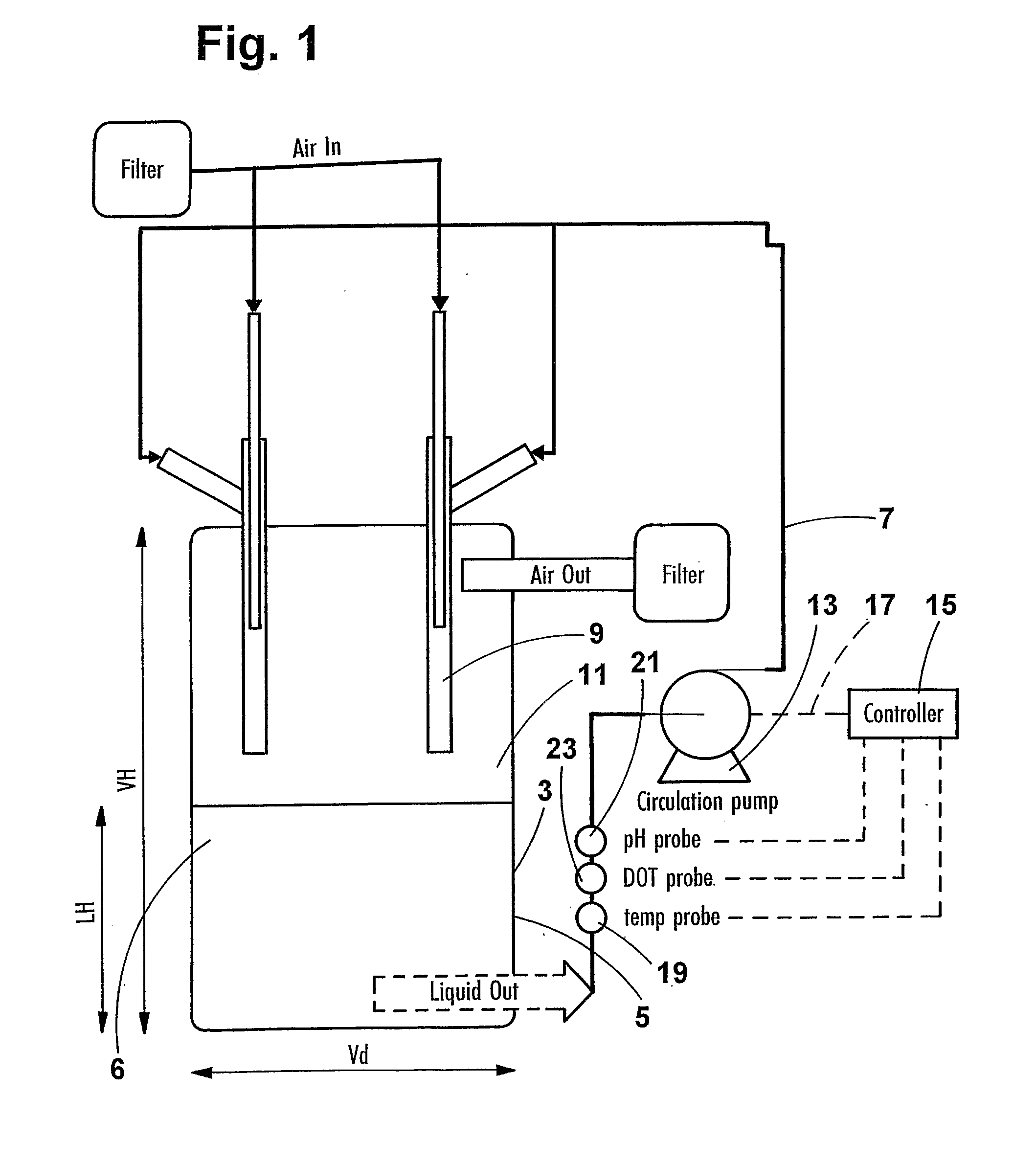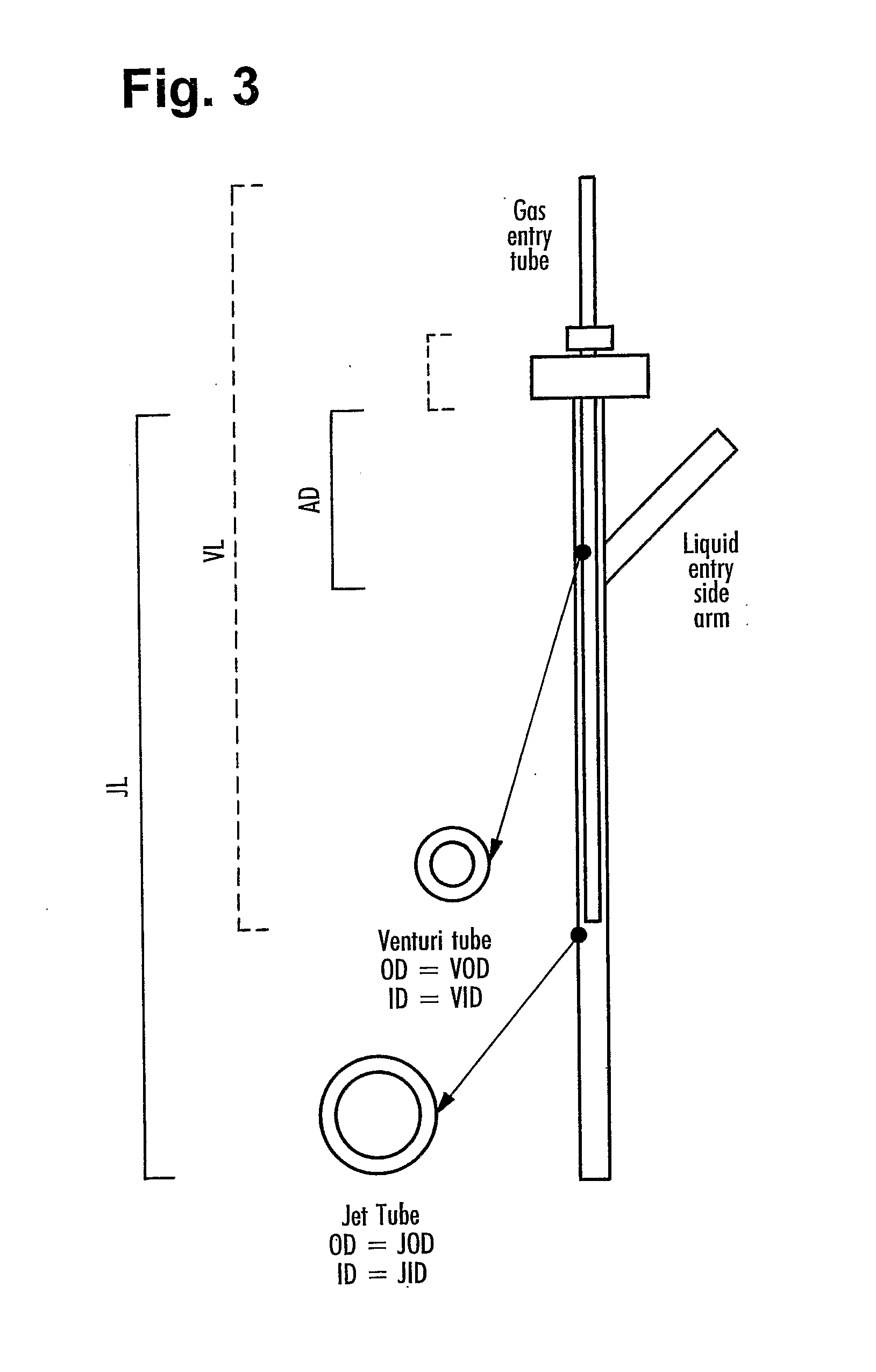Bioreactor
a bioreactor and microorganism technology, applied in the field of microorganism and cell culturing, can solve the problems of imposing a time burden and cost on the efficient operation of a manufacturing plant, affecting the quality of the final product, and requiring a significant amount of time for cleaning and re-validation analysis, so as to achieve convenient use, improve gas exchange, and grow safely
- Summary
- Abstract
- Description
- Claims
- Application Information
AI Technical Summary
Benefits of technology
Problems solved by technology
Method used
Image
Examples
example 1
Identification of Design Parameters in a Scale Down Model Venturi Plunging Jet Bioreactor
[0063] To guide the design of a disposable reactor, a conventional non-disposable reactor was configured to operate in both stirred tank and disposable mode to allow direct comparison of the two culture systems. A water jacketed Applikon bioreactor with a total volume of 7 L was used in all design studies. The headplate was fitted with two venturi jets and an external circulation loop. The bioreactor contents were pumped from the vessel using a Quattro diaphragm pump via a wide bore harvest tube circulated back to the venturi jets in a similar manner as shown in FIG. 1. The dimensions of the venturi jets (illustrated in FIG. 3) were detailed above. The jet flow rates were between 5 and 9 liters per minute (equivalent to 2.95 and 5.3 meters / sec). The bioreactor was also equipped with baffles, pH probe (Ingold) and polarographic DOT probe (Mettler Toledo) and a PT100 Temperature probe inserted i...
example 2
Optimisation of Design Parameters in a Scale Down Model Venturi Plunging Jet Bioreactor
[0074] Example 1 identified the venturi ratio, jet angle and to a more limited extent jet crimpling as important design parameters that affect the performance of a venturi plunging jet-based bioreactor. Although jet height was not identified as an important parameter, jets were set to the highest possible position (i.e. the highest possible position that can ensure angled entry of the jet into the culture fluid). Bin (Bin, A. K., 1993, Chem. Eng. Sci. 48 (21): 3585-3630) identified jet height as an important design parameter for plunging jets. In the single use bag design, this would prevent damage to the bag integrity during packaging and transportation. In this example a response surface design approach is used characterise the performance of the venturi jet in response to gas flow rate, liquid flow rate and venturi ratio where jet height was set high. The jets were fitted with 15° angles and ...
example 3
Comparison of Small Scale Model Venturi Plunging Jet Operation to Venturi Plunging Jets for a 50 L Working Volume Single Use Bioreactor
[0083] In this example, the small scale venturi plunging jet was scaled up to the dimensions for a pilot scale disposable bioreactor with a working volume of 50 L. The liquid jet velocity exiting the pilot scale were kept in the same range as the liquid velocities used in Example 1 and example 2. The dimensions for the scaled up jet are shown in FIG. 3.
[0084] Two large scale jets with 15° jet outlet angles were fixed to an opened topped 100 L vessel containing water at 25° C. Oxygen transfer rates were measured using the same DOT probe set up as in example 1 and 2. Jets were set at low medium and high jet height. (10, 20 and 30 cm above the ungassed liquid height). FIG. 12 compares the KLa predicted from the small scale model to the KLa obtained from the scaled up jets. The results from the small scale and scaled up venturi plunging jets are in go...
PUM
 Login to View More
Login to View More Abstract
Description
Claims
Application Information
 Login to View More
Login to View More - R&D
- Intellectual Property
- Life Sciences
- Materials
- Tech Scout
- Unparalleled Data Quality
- Higher Quality Content
- 60% Fewer Hallucinations
Browse by: Latest US Patents, China's latest patents, Technical Efficacy Thesaurus, Application Domain, Technology Topic, Popular Technical Reports.
© 2025 PatSnap. All rights reserved.Legal|Privacy policy|Modern Slavery Act Transparency Statement|Sitemap|About US| Contact US: help@patsnap.com



